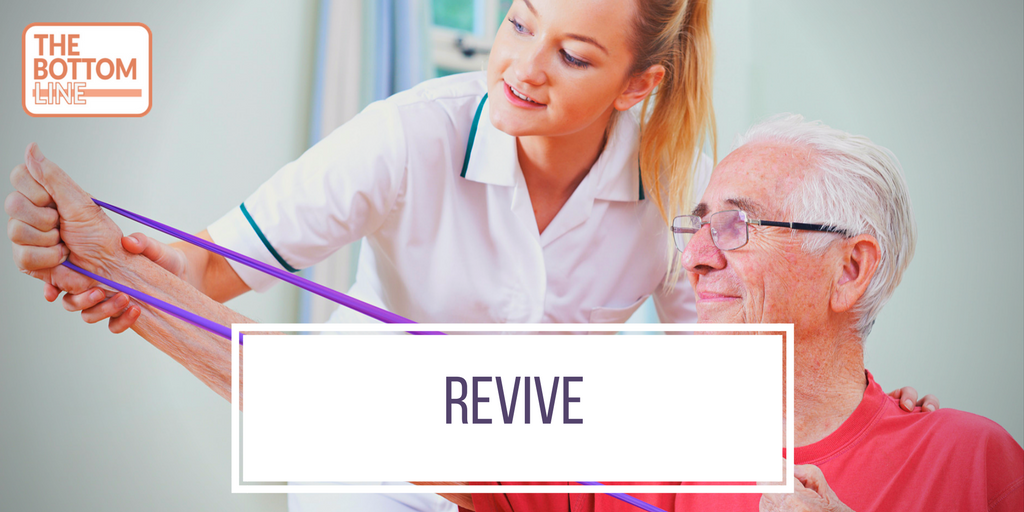REVIVE

Effectiveness of an exercise programme on physical function in patients discharged from hospital following critical illness
McDowell. Thorax 2017; 72:600-609. doi:10.1136/thoraxjnl-2016-209576
Clinical Question
- In patients that survive critical illness, does a post-discharge exercise programme compared to standard post-discharge care improve physical function?
Background
- Survivors of critical illness often will suffer from reduced physical function, exercise capacity, health related quality of life and increased healthcare utilisation, which may continue for up to 5 years following discharge from hospital
- There are very few studies exploring rehabilitation programmes following hospital discharge for patients requiring intensive care
Design
- Multi-centre, randomised, controlled trial
- Allocation concealed by centralised online system and variable permuted blocks
- Assessors were blinded to allocation and patients were instructed not to reveal
- In the absence of prior data, the Cohen method was used to estimate that 52 patients were required (Postulated “medium effect” with Cohen’s d = 0.5)
- This is an alternative to a precise power calculation
- Sample size was increased to 68 to allow for drop-out of 25%
Setting
- Six Intensive Care Units in Northern Ireland
- December 2011 to December 2014
Population
- Inclusion: 18 years or older; mechanically ventilated for > 96 hours
- Exclusion: planned to be discharged home; medically fit to participate; not engaged in other rehabilitation programme
- 1118 screened (293 died, 765 excluded), 60 patients were randomised, 55 patients were analysed at primary end-point
- Baseline demographics (Exercise group vs Standard care group)
- Mean age: 51 vs 51
- Gender: 43% male vs 70% male
- Primary respiratory diagnosis: 57% vs 43%
- Mean APACHE 2: 17 vs 15
- Several baseline measurements for secondary outcomes were significantly worse in Exercise group compared to Standard care group
Intervention
- 6-week post-discharge individualised exercise programme
- Patients received all standard care in addition to the exercise programme
- Physiotherapists underwent standardised training and were given a comprehensive intervention pack with exercise instructions and suggestions for modifications
- 6-week programme (could be delivered over 10 weeks to allow for non-attendance)
- Twice weekly supervised session at hospital gym (or patient’s home if required)
- Once weekly unsupervised session at patient’s home
- Each session was up to one hour and included
- Warm up
- Circuits of arm, leg and whole-body conditioning and strengthening exercises
- Aerobic exercise such as walking or cycling for 10 to 30 minutes
- Cool down and relaxation
- Although intended to be a group session, the recruitment rate and geography meant that patients received this therapy individually
Control
- Standard post-discharge care
- Nothing above the local post-discharge care provided by each hospital
Outcome
- Primary outcome: No statistically significant difference was demonstrated in the improvement from baseline of the physical functioning component of the SF-36 Health Survey at 6-weeks (end of exercise programme), although the point estimate was equal to the clinically meaningful difference previously defined
- SF-36 Physical Function mean change in score
- Exercise group: +6.8 (SD 10.9)
- Standard care group: +3.9 (SD 8.2)
- Difference of mean change from baseline: 3.0 (95% CI -2.2 to 8.2; P = 0.26)
- This was not sustained when measured at 6 months
- SF-36 Physical Function mean change in score
- Secondary outcome: Many of the secondary outcomes measured at 6-weeks demonstrated a statistically significant difference in favour of the exercise group (expressed as between group difference in the mean change from baseline)
- SF-36 Role Physical: 6.6 (95% CI 0.73 to 12.5; P = 0.03)
- Incremental Shuttle Walk Test: 83.1m (95% CI 8.3 to 157.9; P = 0.03)
- Functional Limitation Profile: -4.8 (95% CI -8.7 to -0.9; P = 0.02)
- Chronic disease self-efficacy scale: 2.2 (95% CI 0.8 to 3.7; P = 0.01)
- Readiness to exercise: 1.3 (95% CI 0.8 to 1.9; P < 0.001)
- Other secondary outcomes at 6-weeks were not statistically significant
- All but ‘readiness to exercise’ were not sustained at medium-term follow-up (6 months)
Authors’ Conclusions
- After discharge from hospital following critical illness, a 6 week individualised exercise programme did not improve self-reported physical fitness at 6 weeks or 6 months, although encouraging results in secondary outcomes should be used for further studies on this theory
Strengths
- Rehabilitation after critical illness is an important topic to research
- Well designed multi-centre trial across a regional research unit
- Good inclusion of patients at the more severe end of critical illness spectrum, in whom an intervention like this is most likely to be effective
- Anticipated high drop-out rate and reasonable effort to estimate necessary sample size
- Appropriate efforts to maintain concealment of allocation and blinding where possible, which will reduce systematic bias
- Well established patient-centred primary outcome that investigates how the patient feels rather than what we measure
Weaknesses
- Despite appropriate randomisation, there were imbalances in the baseline demographic and measured variables between the groups
- The bias of this is uncertain as the outcome variables were differences in the individual paired before-after measurements
- An Analysis of Covariance (ANCOVA) adjusted for these differences but this did not change the conclusion
- Only 7.8% of screened patients were recruited, due to death or exclusion criteria, which may reduce the generalisability
- A cost-analysis would have been useful, as an intervention like this will be demanding on resources
- As the point estimate and 95% CIs of the primary outcome overlapped the pre-specified clinically meaningful value (+3 score change from baseline, on a 0-100 scale), this trial does not rule out that this intervention is useful, but a much larger trial will be needed to draw a stronger conclusion (i.e. risk of type 2 error if we accept the null hypothesis)
- This trial only investigated one form of physical rehabilitation – it isn’t clear from this trial alone if the theory (rehabilitation after critical illness is good for patients) is wrong or if the specific intervention (thrice weekly individualised 1-hour exercise session) is ineffective
The Bottom Line
- The research group should be commended for investigating this important but complex aspect of critical illness
- No clear benefit was demonstrated when patients at the sicker end of the critical illness spectrum were given a 6-week individualised exercise programme after hospital discharge
- Any possible benefit appears lost by 6 months
External Links
- [article] Effectiveness of an exercise programme on physical function in patients discharged from hospital following critical illness (the REVIVE trial)
- [further reading] NICE CG83: Rehabilitation after Critical Illness
- [further reading] Reading ICU Support Network: Rehabilitation and Follow-up after Critical Illness
Metadata
Summary author: Duncan Chambler
Summary date: 21 June 2017
Peer-review editor: Steve Mathieu



